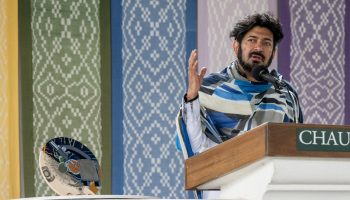By David Levy
Carnival Overture, Op. 92 Antonin Dvořák
The Czech master Antonin Dvořák was born in Nelahozeves, near Kralupy, on Sept. 8, 1841, and died in Prague on May 1, 1904. His “Carnival Overture” (originally titled “Life”), composed in 1891, is one of his liveliest and most popular short works for orchestra. The work was first performed in Prague on April 28, 1892, just before the composer departed for the United States. It is scored for piccolo, two flutes, two oboes, English horn, two clarinets, two bassoons, four horns, two trumpets, three trombones, tuba, timpani, percussion, harp and strings.
Dvořák’s symphonies, particularly No. 7, 8 and 9 (“From the New World”), the Cello Concerto and the orchestrated version of his Slavonic Dances are his most frequently performed symphonic works. To this list may be added the one exception among his five symphonic poems, the “Carnival Overture.” That work, written in 1891, takes place in the middle of a trilogy of concert overtures collectively labeled “Nature, Life, and Love.”
The overture’s title refers to the pre-Lenten season that is celebrated so colorfully in various parts of the world, culminating in Shrove Tuesday (Mardi Gras). The composer indicated that the “Carnival Overture” expresses the sentiments of “a lonely, contemplative wanderer reaching at twilight a city where a carnival is in full sway. On every side is heard the clangor of instruments mingled with the shouts of joy and unrestrained hilarity of people giving vent to their feelings in songs and dance tunes.” The lively opening and closing sections flank a more subdued middle part that may be indicative of the “wanderer” and his feelings. But it is the general exuberance of the outer sections, with their brilliant splashes of orchestral color, that has endeared this work to audiences.
Concerto No. 1 for Violin and Orchestra in G Minor, Op. 26 Max Bruch
The German composer Max (Christian Friedrich) Bruch was born in Cologne on Jan. 6, 1838, and died in Friedenau, Berlin, on Oct. 2, 1920. A child prodigy, Bruch won the Frankfurt Mozart-Stiftung Prize when he was only 14 years old. He was a composer of extremely wide range, devoting his efforts largely to works for chorus and stage, including three operas. The largest body of his work was devoted to sacred and secular choral compositions, and he also wrote several songs for voice and piano.
Bruch was a gifted conductor and teacher (Ottorino Respighi and Ralph Vaughan Williams were among his composition pupils). Among the positions he held was the post of music director at Koblenz and Sondershausen. He held conducting posts in Berlin, Liverpool and Breslau (now Wrocław, Poland). He ended his career as director of a master class in composition at the Hochschule für Musik in Berlin. It is curious that his fame today rests almost entirely on one piece, his Violin Concerto no. 1, op. 26 (he composed three, and considered his second to be the best of them). Violinists have Bruch to thank for his fine setting of the sacred Jewish chant, “Kol nidrei,” and many cellists are fond of performing his “Shelomo” (Hebrew Rhapsody).
The original version of Bruch’s Concerto No. 1 contains ideas that reach back to 1857, and was composed between 1865 and 1866. It received its premiere in Koblenz on April 24, 1866, with Otto von Königsllöw as soloist and the composer conducting. The revised version, which is the one normally heard, was prepared with the assistance of the virtuoso Joseph Joachim, who performed it on Jan. 5, 1868, in Bremen, with Carl Martin Reinthaler conducting. It is scored for solo violin, two flutes, two oboes, two clarinets, two bassoons, four horns, two trumpets, timpani and strings.
It would be tempting to label Bruch a “one hit wonder,” based on the great popularity of his Violin Concerto No. 1. That, of course, would be wrong, given the high quality of many of his other works. Bruch himself deemed his Concerto No. 2 to be superior, but it is rarely performed (the Concerto No. 3 is performed even less frequently). Jascha Heifetz made a splendid case for Bruch’s “Scottish Fantasy,” a work that in recent years has been getting played more often. Cellists also regularly perform his “Schelomo for Cello and Orchestra.” Bruch’s natural gift for lyricism favored the violin as soloist over the piano, but his output boasts several operas and choral works which are rarely heard, not to mention three symphonies.
What, one might ask, are the reasons for the neglect of Bruch’s music outside of those few compositions? The answer lies in part in his dates. Born five years after Johannes Brahms and overlapping with the careers of Mendelssohn and Schumann, Bruch was a conservative composer who resisted the influence of the “modernists” Liszt and Wagner, who dominated the German music scene in the latter 19th century. If one accepts the label of Brahms as “conservative,” Bruch’s career was overshadowed by his slightly older contemporary.
One can only hope that musicians will want to take a second look at this fine composer’s more neglected works and that a champion might emerge in the future.
None of that, however, takes away from the masterly nature of the Violin Concerto No. 1. Its first movement, Prelude: Allegro moderato, begins with a melancholy sequence in the winds, answered by the soloists, before launching into a fiery display of violinistic virtuosity, balanced by intense lyricism. As is the case with Mendelssohn’s equally famous Violin Concerto in E Minor, Bruch connects the first movement directly to the second, an Adagio of sublime melodiousness. This in turn leads straight away to the Finale: Allegro energico, filled with gypsy passion that alternates with a soaring melody that sticks in the memory of all who hear it.
Excerpts from the ballet, ‘Romeo and Juliet,’ Op. 64 Sergei Prokofiev
Sergei Prokofiev, one of the 20th century’s leading composers was born in Sontsovka (Ukraine) on April 23, 1891, a date that fell near the end of the era of Tsarist rule. It is one of history’s greatest ironies that Prokofiev died on March 5, 1953, the same day as the Communist dictator, Joseph Stalin. Stalin’s repressive policies had a powerful, and often deleterious effect on the careers of Prokofiev and his colleague, Dmitri Shostakovich. Prokofiev’s ballet score, “Romeo and Juliet,” was composed during the spring and summer of 1935 and received its first performance in Brno, Czechoslovakia, on Dec. 30, 1938, but only after it had been rejected by the Bolshoi company for a variety of reasons, some of which were political as much as due to objections to the composer’s and director’s alteration of the plot ending, as well as its suitability for dancing. Prokofiev extracted two concert suites (Op. 64bis and Op. 64ter) in 1936 and 1937, which were performed in Moscow to considerable approbation. After much revising, the entire ballet was performed in Leningrad at the Kirov Ballet on Jan. 10, 1940.
The suites are scored for piccolo, two flutes, two oboes, English horn, two clarinets, bass clarinet, two bassoons, contrabassoon, tenor saxophone, four horns, three trumpets, three trombones, tuba, harp, a large array of percussion and strings.
Two households, both alike in dignity,
In fair Verona, where we lay our scene,
From ancient grudge break to new mutiny,
Where civil blood makes civil hands unclean.
From forth the fatal loins of these two foes
A pair of star-crossed lovers take their life
Whose misadventured piteous overthrows
Doth with their death bury their parents’ strife.
The fearful passage of their death-marked love,
And the continuance of their parents’ rage,
Which, but their children’s end, nought could remove,
Is now the two hours’ traffic of our stage;
The which if you with patient ears attend,
What here shall miss, our toil shall strive to mend.
William Shakespeare, Prologue to Romeo and Juliet
This program by the Chautauqua Symphony Orchestra includes musical responses by one of the 20th century’s musical masters. Prokofiev, to one of history’s greatest dramatic love stories, William Shakespeare’s immortal Romeo and Juliet. It stands proudly with other great musical adaptations such as Hector Berlioz’s semi-opera/symphony, Tchaikovsky’s Overture-Fantasy, and Leonard Bernstein’s musical, West Side Story.
Prokofiev’s ballet, Romeo and Juliet, was composed in 1935-36. Prokofiev originally amazed and scandalized Russian Shakespeare “purists” by permitting the lovers to survive, thus creating a happy ending. The composer’s response to this criticism was typically terse for him:
“Living people can dance, the dying cannot.”
The dancers raised their own objections to the score, complaining that some of its music was inaudible, and thus undanceable. Eventually Prokofiev capitulated, and his 1939 revision of the score reinstated the tragic conclusion, as well as reinforcing its orchestration. A film version of the ballet followed some years later. Audiences of orchestral music are familiar with the two suites that Prokofiev extracted from the ballet.
Tonight’s CSO concert will feature an amalgam taken from both suites of 1936-37. A third suite, created in 1956, also exists (Op. 101).
Our excerpts for this performance come close to restoring the order of events in Shakespeare’s play:
I. Scene. The Street Awakens (Suite No. 1)
II. Montagues and Capulets (Suite No. 2)
III. Juliet as a Young Girl (Suite No. 2)
IV. Friar Laurence (Suite No. 2)
V. Menuet (Suite No. 1)
VI. Masks (Suite No. 1)
VII. Romeo and Juliet (Suite No. 1)
VIII. Death of Tybalt (Suite No. 1)
IX. Romeo at Juliet’s Grave (Suite No. 2)
David B. Levy is professor of music at Wake Forest University in Winston-Salem, North Carolina.






